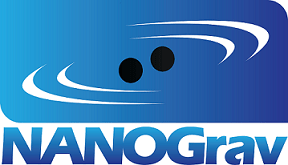गुरुत्वाकर्षण तरंग was directly detected for the first time in 2015 after a century of its prediction by Einstein’s General Theory of Relativity in 1916. But, the continuous, low frequency गुरुत्वीय-wave Background (GWB) that is thought to be present throughout the ब्रम्हांड has not been detected directly so far. The researchers at North American Nanohertz Observatory for गुरुत्वाकर्षण लहरों (NANOGrav) have recently reported detection of a low-frequency signal that could be ‘Gravitational-wave Background (GWB)’.
1916 में आइंस्टीन द्वारा प्रतिपादित सापेक्षता का सामान्य सिद्धांत भविष्यवाणी करता है कि प्रमुख ब्रह्मांडीय घटनाएं जैसे सुपरनोवा या काला छेद उत्पादन करना चाहिए गुरुत्वाकर्षण लहरों जो के माध्यम से प्रचारित होता है ब्रम्हांड. Earth should be awash with गुरुत्वाकर्षण लहरों from all directions all the time but these are undetected because they become extremely weak by the time they reach earth. It took about a century to make a direct detection of gravitational ripples when in 2015 LIGO-Virgo team was successful in detecting गुरुत्वाकर्षण लहरों produced due to merger of two काला छेद situated at a distance of 1.3 billion light-years from the Earth (1). इसका मतलब यह भी था कि खोजी गई तरंगें लगभग 1.3 अरब साल पहले हुई ब्रह्मांडीय घटना के बारे में जानकारी के वाहक थे।
2015 में पहली बार पता लगाने के बाद से, अच्छी संख्या में गुरुत्वाकर्षण तरंग have been recorded till date. Most of them were due to merger of two काला छेद, few were due to collision of two neutron stars (2). All detected गुरुत्वाकर्षण लहरों so far were episodic, caused due to binary pair of काला छेद or neutron stars spiralling and merging or colliding with each other (3) और उच्च आवृत्ति, लघु तरंग दैर्ध्य (मिलीसेकंड रेंज में) के थे।
However, since there is possibility of large number of sources of गुरुत्वाकर्षण लहरों में ब्रम्हांड hence many गुरुत्वाकर्षण लहरों together from all over the ब्रम्हांड may be continuously passing through the earth all the time forming a background or noise. This should be continuous, random and of low frequency small wave. It is estimated that some part of it may even have originated from the Big Bang. Called गुरुत्वीय-wave Background (GWB), this has not been detected so far (3).
But we may be on the verge of a breakthrough – the researchers at the North American Nanohertz Observatory for गुरुत्वाकर्षण लहरों (NANOGrav) have reported detection of a low-frequency signal that could be ‘Gravitational-wave Background (GWB) (4,5,6).
Unlike LIGO-virgo team who detected गुरुत्वाकर्षण तरंग from individual pairs of काला छेद, NANOGrav team have looked for persistent, noise like, ‘combined’ गुरुत्वाकर्षण तरंग created over very long period of time by countless blackholes में ब्रम्हांड. The focus was on ‘very long wavelength’ गुरुत्वाकर्षण तरंग at the other end of ‘gravitational wave spectrum’.
प्रकाश और अन्य विद्युत चुम्बकीय विकिरणों के विपरीत, गुरुत्वाकर्षण तरंगों को सीधे दूरबीन से नहीं देखा जा सकता है।
नैनोग्राव टीम ने चुना मिलीसेकंड pulsars (MSPs) that rotate very rapidly with long term stability. There is steady pattern of light coming from these pulsers which should be altered by the gravitational wave. The idea was to observe and monitor an ensemble of ultra-stable millisecond pulsars (MSP) for correlated changes in the timing of the arrival of the signals at the Earth thus creating a “आकाशगंगा-sized” gravitational-wave detector within our own आकाशगंगा. The team created a pulsar timing array by studying 47 of such pulsars. The Arecibo Observatory and the Green Bank Telescope were the रेडियो telescopes used for the measurements.
अब तक प्राप्त आंकड़ों में 47 एमएसपी और 12.5 वर्षों से अधिक के अवलोकन शामिल हैं। इसके आधार पर, GWB की प्रत्यक्ष पहचान को निर्णायक रूप से साबित करना संभव नहीं है, हालांकि पता चला कम आवृत्ति संकेत बहुत अधिक संकेत देते हैं। शायद, अगला कदम सरणी में अधिक पल्सर को शामिल करना और संवेदनशीलता को बढ़ाने के लिए लंबे समय तक उनका अध्ययन करना होगा।
अध्ययन करने के लिए ब्रम्हांड, scientists were exclusively dependant on electromagnetic radiations like light, X-ray, रेडियो wave etc. Being completely unrelated to electromagnetic radiation, detection of gravitational in 2015 opened a new window of opportunity to scientists to study celestial bodies and understanding the ब्रम्हांड especially those celestial events which are invisible to electromagnetic astronomers. Further, unlike electromagnetic radiation, gravitational waves do not interact with matter hence travel virtually unimpeded carrying information about their origin and source free of any distortion.(3)
Detection of Gravitational-wave Background (GWB) would broaden the opportunity further. It may even become possible to detect the waves generated from Big Bang which may help us understand origin of ब्रम्हांड बेहतर तरीके से।
***
सन्दर्भ:
- Castlvecchi D. और Witze A.,2016। आइंस्टीन की गुरुत्वाकर्षण तरंगें आखिर में मिलीं। प्रकृति समाचार 11 फरवरी 2016। डीओआई: https://doi.org/10.1038/nature.2016.19361
- Castlvecchi D., 2020। ब्रह्मांड के बारे में 50 गुरुत्वाकर्षण-लहर की घटनाओं से क्या पता चलता है। प्रकृति समाचार 30 अक्टूबर 2020 को प्रकाशित। डीओआई: https://doi.org/10.1038/d41586-020-03047-0
- LIGO 2021. गुरुत्वाकर्षण तरंगों के स्रोत और प्रकार। पर ऑनलाइन उपलब्ध है https://www.ligo.caltech.edu/page/gw-sources 12 जनवरी 2021 को एक्सेस किया गया।
- NANOGrav सहयोग, 2021। NANOGrav लो-फ़्रीक्वेंसी ग्रेविटेशनल वेव बैकग्राउंड के संभावित 'पहले संकेत' ढूँढता है। पर ऑनलाइन उपलब्ध है http://nanograv.org/press/2021/01/11/12-Year-GW-Background.html 12 जनवरी 2021 को एक्सेस किया गया
- NANOGrav सहयोग 2021. प्रेस ब्रीफिंग - NANOGrav डेटा के 12.5 वर्षों में गुरुत्वाकर्षण-तरंग पृष्ठभूमि की खोज। 11 जनवरी 2021। ऑनलाइन उपलब्ध है http://nanograv.org/assets/files/slides/AAS_PressBriefing_Jan’21.pdf
- Arzoumanian Z., et al 2020. NANOGrav 12.5 yr डेटा सेट: एक आइसोट्रोपिक स्टोकेस्टिक ग्रेविटेशनल-वेव बैकग्राउंड के लिए खोजें। द एस्ट्रोफिजिकल जर्नल लेटर्स, वॉल्यूम 905, नंबर 2। डीओआई: https://doi.org/10.3847/2041-8213/abd401
***






































